 A childhood history book included a reproduction of Jacques-Louis David’s famous portrait of Napoleon crossing the Alps. It’s an idealized representation, not a realistic one. Mounted on a rearing Marengo – his grey Arabian stallion – the man who became emperor of the French and conqueror of Europe gives off an invincible vibe.
A childhood history book included a reproduction of Jacques-Louis David’s famous portrait of Napoleon crossing the Alps. It’s an idealized representation, not a realistic one. Mounted on a rearing Marengo – his grey Arabian stallion – the man who became emperor of the French and conqueror of Europe gives off an invincible vibe.
Two recent news stories brought that image to mind.
One was on the 200th anniversary of Napoleon’s May 5, 1821, death. And the other was on the idea of placing a reproduction of Marengo’s skeleton over Napoleon’s Les Invalides tomb.
Born Napoleon Bonaparte on the French island of Corsica in 1769, he’s one of history’s dominant figures. He was many things: dictator, superbly gifted military commander and significant legal reformer. Some regard him as an intellectual father of the European Union.
Following his June 1815 defeat at Waterloo and subsequent abdication, Napoleon wanted to migrate to the United States. But the victorious European powers wouldn’t go for that. So on July 15, 1815, he surrendered to a British ship and was taken into custody as a prisoner of war.
It probably saved his life. Many of those who’d fought him, particularly the Prussians, wanted him dead.
One of Napoleon’s saviours was the Duke of Wellington, the man who beat him at Waterloo. As Wellington directly expressed it, “if the Sovereigns wished to put him to death they should appoint an executioner, which should not be me.”
Rather than being delivered to a firing squad or scaffold, Napoleon was exiled to St. Helena, a remote island in the South Atlantic that was uninhabited when the Portuguese discovered it in the early 16th century. It subsequently came into British hands and Napoleon arrived there on a British ship in October 1815. He never left alive.
Napoleon bitterly resented this fate, blaming it on Wellington. In fact, the British government made the decision on the recommendation of a London civil servant. Napoleon had escaped from an earlier exile on the island of Elba off Italy and no chances were to be taken this time.
FROM THE ARCHIVES: Napoleon’s Waterloo was 200 years ago by Pat Murphy
His second wife, Marie Louise of Austria, didn’t accompany him to St. Helena. Their 1810 marriage had been a political one, calculated to legitimize the dynasty he intended to found and to divide his enemies.
But despite the circumstances and the substantial age difference, the marriage produced an heir and seems to have been reasonably harmonious, perhaps even affectionate. However, she hadn’t accompanied him to Elba either and had become romantically involved with an Austrian count to whom she subsequently bore three children.
The St. Helena exile brought out some of Napoleon’s lesser characteristics. You might describe it as egomania.
He was obsessed with self-justification. The crucial defeat at Waterloo was everybody’s fault except his. He’d been surrounded by incompetents and traitors.
The weirdest bit was the constant denigration of Wellington’s ability. Wellington was a second-rate general who lacked imagination. And his tactics at Waterloo had been all wrong. Indeed, sound strategy held that Wellington should never have engaged there!
It was criticism bordering on the bizarre. To quote historian Andrew Roberts, “there is something comic about the emperor complaining that his victorious opponents failed to observe the conventions of warfare.”
Wellington, for his part, was more generous in assessing Napoleon. Of course, there was a crafty element of self-promotion at work. If Napoleon had been one of history’s greatest commanders, surely the man who beat him was no slouch.
Then there was the matter of Napoleon’s will. It raised some eyebrows.
The multiple bequests came to just shy of seven million francs, and included one for the French officer who tried to assassinate Wellington in Paris in 1818. Unfortunately for the beneficiaries, the estate lacked the requisite funds.
The other figure in the famous crossing-the-Alps portrait – the stallion Marengo – did rather better than his rider.
Taken to England in the wake of Waterloo, Marengo became an equine celebrity and a star attraction at public events. Later in life, he stood at stud. When he died in 1831, his skeleton was preserved and now – recently refurbished and cleaned – is on display at London’s National Army Museum.
Marengo was 38 years old at the end, which translates to around 105 in human terms. This gives a lifespan more than twice that of Napoleon, who died at age 51.
Troy Media columnist Pat Murphy casts a history buff’s eye at the goings-on in our world. Never cynical – well perhaps a little bit. For interview requests, click here.
The views, opinions and positions expressed by columnists and contributors are the authors’ alone. They do not inherently or expressly reflect the views, opinions and/or positions of our publication.
© Troy Media
Troy Media is an editorial content provider to media outlets and its own hosted community news outlets across Canada.

